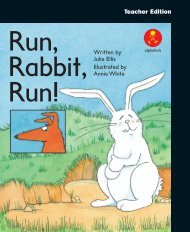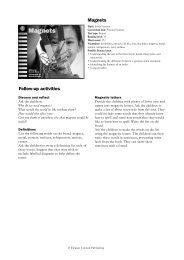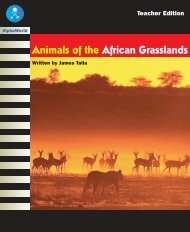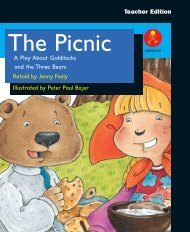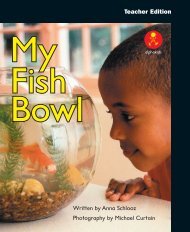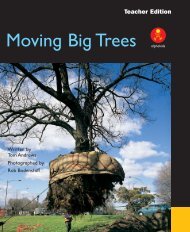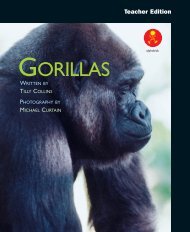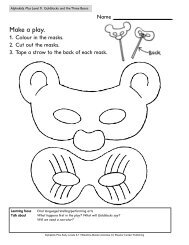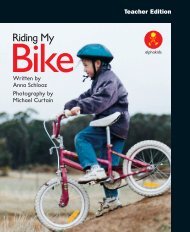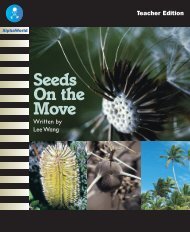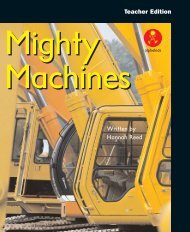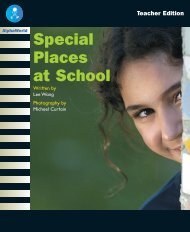The Ungrateful Tiger
The Ungrateful Tiger
The Ungrateful Tiger
You also want an ePaper? Increase the reach of your titles
YUMPU automatically turns print PDFs into web optimized ePapers that Google loves.
Teacher Edition<br />
<strong>The</strong><br />
<strong>Ungrateful</strong><br />
<strong>Tiger</strong><br />
alphakids<br />
Written by Julie Ellis<br />
Illustrated by Chantal Stewart
HORWITZ GARDNER<br />
LIMITED<br />
168e High Street<br />
Egham, Surrey<br />
TW20 9HP<br />
United Kingdom<br />
Published edition<br />
© Eleanor Curtain<br />
Publishing 2004<br />
Text © Nicole di Marco<br />
Photographs<br />
© Eleanor Curtain<br />
Publishing<br />
First published 2004<br />
Apart from any fair dealing for<br />
the purposes of study, research,<br />
criticism or review, as<br />
permitted under the Copyright<br />
Act of Australia, no part of this<br />
book may be reproduced by<br />
any process, or transmitted in<br />
any form, without permission<br />
of the copyright owner. Where<br />
copies of part or the whole of<br />
this book are made under Part<br />
VB of the Copyright Act, the<br />
law requires that records of<br />
such copying be kept and the<br />
copyright owner is entitled to<br />
claim payment.<br />
Developed by<br />
Eleanor Curtain Publishing<br />
Designed by<br />
Alexander Stitt<br />
Production by<br />
Publishing Solutions<br />
Printed in China<br />
ISBN 0 7253 3271 9<br />
1 2 3 4 5 6 7 8 9<br />
04 05 06<br />
How to use this book<br />
<strong>The</strong> Alphakids Plus teacher<br />
editions support teachers as they<br />
guide children’s reading and<br />
thinking during one or more guided<br />
reading sessions. Teachers can<br />
observe children as they read and<br />
choose from the given suggestions<br />
to suit individual needs.<br />
Before reading<br />
Setting the context, front cover<br />
and title page:<br />
<strong>The</strong> suggestions help teachers to<br />
set the scene and prepare children<br />
for reading the book. Prompts help<br />
to determine children’s prior<br />
knowledge. Where necessary,<br />
background information is<br />
provided. Teachers are encouraged<br />
to check that children understand<br />
the vocabulary listed and to discuss<br />
the meanings and/or the structures<br />
of these words. Previous<br />
experiences with similar text types<br />
may also be discussed.<br />
During reading<br />
Predict, Read, Reflect:<br />
Questions encourage children to<br />
engage with the text by making<br />
predictions. <strong>The</strong>y then read a<br />
section of the text and reflect on<br />
what they have read. <strong>The</strong> focus is<br />
on the content, language and text<br />
features of the book.<br />
Observe and support:<br />
Prompts help teachers to focus on<br />
the strategies children use as they<br />
read. Teachers can then select from<br />
and adapt the suggestions according<br />
to the needs of the individual child.<br />
<strong>The</strong> suggestions aim to develop a<br />
child’s reading abilities.<br />
Interruptions to the child’s reading<br />
should be minimal.<br />
After reading<br />
A selection of reading and writing<br />
activities:<br />
<strong>The</strong> last pages of the teacher edition<br />
provide follow-up activities and<br />
include the assessment focus.<br />
Selected text features<br />
• <strong>The</strong> story is written in the form of a<br />
folk tale – ‘Once upon a time there<br />
was…’<br />
• Direct speech is used throughout<br />
Vocabulary<br />
exactly, frightened, howling, jungle,<br />
nervously, peaceful, search, ungrateful,<br />
village, wondered
Setting the context<br />
Have you ever read any stories about tigers<br />
What were the tigers like What did they do<br />
Should you ever trust a tiger Why<br />
If you helped a tiger, do you think it would be grateful Why<br />
<strong>The</strong><br />
<strong>Ungrateful</strong><br />
<strong>Tiger</strong><br />
Written by Julie Ellis<br />
Illustrated by Chantal Stewart<br />
alphakids<br />
<strong>The</strong><br />
<strong>Ungrateful</strong><br />
<strong>Tiger</strong><br />
Written by Julie Ellis<br />
Illustrated by Chantal Stewart<br />
alphakids<br />
Front cover and title page<br />
What sort of book do you think this will<br />
be How can you tell<br />
What sort of character do you think the<br />
tiger will be
<strong>The</strong> <strong>Ungrateful</strong> <strong>Tiger</strong> Pages 2–3<br />
Predict<br />
Look at the pictures on pages 2 and 3.<br />
What is the tiger doing What are the people doing<br />
Why<br />
Ask the children to read the first sentence of the story.<br />
What does this sentence tell us about the type of story<br />
this will be<br />
Read to the end of page 3.<br />
Reflect<br />
What sort of village does Sunni live in<br />
Why were the villagers frightened<br />
How did they try to solve their problem<br />
Observe and support<br />
Can the child identify features of a folk tale<br />
Where does this story take place<br />
Who are the characters in the story What do we<br />
know about them<br />
What details about the story have been included on<br />
these pages<br />
2
Once upon a time there was a boy named<br />
Sunni who lived in a small village near the<br />
jungle.<br />
It was a happy and peaceful place until a<br />
tiger started coming into the village in<br />
search of food.<br />
<strong>The</strong> villagers were very frightened.<br />
<strong>The</strong>y dug a deep pit outside the village to<br />
trap the tiger.<br />
2 3<br />
3
<strong>The</strong> <strong>Ungrateful</strong> <strong>Tiger</strong> Pages 4–7<br />
Predict<br />
How do you think Sunni finds the tiger<br />
How might the tiger be feeling How might Sunni be<br />
feeling<br />
What do you think Sunni will do<br />
Read to the end of page 7.<br />
Reflect<br />
Why did Sunni feel sorry for the tiger<br />
Why did Sunni help him out of the pit How do you know<br />
this<br />
Observe and support<br />
Can the child use contextual information to explain<br />
the meaning of new vocabulary<br />
What does it mean to be grateful How did you work<br />
that out<br />
4
One morning Sunni was collecting firewood<br />
when he heard a strange howling.<br />
‘What is making that noise’ he wondered.<br />
He followed the sound until he came to the<br />
pit outside the village. At the bottom of the<br />
pit was a tiger.<br />
<strong>The</strong> tiger looked hungry and unhappy.<br />
When the tiger saw Sunni it cried, ‘Help!<br />
Oh please help me get out of this pit!’<br />
4 5<br />
Sunni felt sorry for the tiger but he knew<br />
that tiger was dangerous.<br />
So he called out, ‘I can’t help you.<br />
You might eat me!’<br />
<strong>The</strong> tiger called back, ‘If you help me, I’ll be<br />
very grateful. I won’t eat you!’<br />
So Sunni decided to help the tiger.<br />
He found a long branch and pushed it into<br />
the pit.<br />
<strong>The</strong> tiger leapt onto the branch and quickly<br />
climbed out.<br />
6<br />
7<br />
5
<strong>The</strong> <strong>Ungrateful</strong> <strong>Tiger</strong> Pages 8–11<br />
Predict<br />
Look at the pictures on pages 8 to 11.<br />
Do you think the tiger will keep his word Why<br />
What are Sunni and the tiger arguing about<br />
What do you think the elephant will suggest<br />
Read to the end of page 11.<br />
Reflect<br />
Why did Sunni cry, ‘That’s not fair’<br />
What does the elephant suggest<br />
How do you think the elephant will help Sunni<br />
Observe and support<br />
Ask one child to read aloud to you while the others<br />
are reading silently. Can the child read the text<br />
fluently Does the child read the text with<br />
expression<br />
Can you read it so that it sounds like Sunni talking<br />
How might he be feeling How might his voice<br />
sound<br />
6
Once the tiger was out of the pit, Sunni<br />
could see that it was very big and strong.<br />
Sunni was scared. He moved away from the<br />
tiger. ‘I think,’ he said nervously, ‘I should<br />
take my firewood back to the village.<br />
My family will be waiting for me.’<br />
And he backed away further.<br />
‘But you said that you would be very<br />
grateful if I helped you get out of the pit!<br />
You said you wouldn’t eat me!’ cried Sunni.<br />
‘I did say that,’ agreed the tiger, ‘but now<br />
that I’m out, I think I’ll eat you anyway.’<br />
‘Wait!’ said the tiger. ‘Not so fast.<br />
I'm hungry. I'm going to eat you up.’<br />
8 9<br />
‘That’s not fair,’ cried Sunni. ‘You tricked me.’<br />
‘I’m very fair,’ said the tiger. ‘But I’m very<br />
hungry too. So I’m going to eat you.’<br />
Sunni agreed immediately.<br />
<strong>The</strong> tiger looked cross. His stomach<br />
rumbled. But he agreed.<br />
As they were arguing, an elephant came by.<br />
<strong>The</strong> elephant said to them, ‘Why don’t you let<br />
me work out if Sunni should be eaten’<br />
10 11<br />
7
<strong>The</strong> <strong>Ungrateful</strong> <strong>Tiger</strong> Pages 12–13<br />
Predict<br />
What is the elephant doing<br />
How does the tiger get back into the pit<br />
Read to the end of page 13.<br />
Reflect<br />
How does the elephant trick the tiger Should he have<br />
done this<br />
What sort of character is the elephant Why do you<br />
think so<br />
Observe and support<br />
Can the child identify a question mark and explain<br />
what it is used for<br />
Can you show me a question mark on page 13<br />
What does it tell you when you are reading<br />
How does your voice sound when you read a<br />
question<br />
8
‘Before I tell you what I think, I need to see<br />
exactly what happened,’ said the elephant.<br />
So they went over to the pit.<br />
‘Show me where you were when Sunni<br />
found you,’ said the elephant to the tiger.<br />
<strong>The</strong> tiger jumped down into the pit.<br />
‘Was this branch in the pit’ asked the<br />
elephant.<br />
‘No, it wasn't,’ said the tiger.<br />
So the elephant quickly pulled the branch<br />
out of the pit.<br />
12 13<br />
9
<strong>The</strong> <strong>Ungrateful</strong> <strong>Tiger</strong> Pages 14–16<br />
Predict<br />
How do you think Sunni will react to the tiger’s situation<br />
What will the elephant and the tiger say to each other<br />
What will happen to the tiger<br />
Read to the end of page 16.<br />
Reflect<br />
How would Sunni be feeling<br />
Does the tiger get what he deserves Why<br />
How would you describe the tiger to someone who has<br />
not read the book<br />
Observe and support<br />
Can the child identify how a folk tale is organised<br />
Can they identify the problem and the resolution<br />
What problem does Sunni face How is it solved<br />
10
Sunni smiled. <strong>The</strong> tiger was trapped in the<br />
pit again!<br />
‘That’s not fair,’ cried the tiger.<br />
‘You tricked me!’<br />
But the elephant said to the tiger,<br />
‘You tricked Sunni into helping you when<br />
you were planning to eat him anyway.<br />
You may be hungry, but you are a most<br />
unfair and ungrateful tiger!’<br />
14<br />
15<br />
<strong>The</strong> elephant turned and walked away.<br />
Sunni picked up his firewood and hurried<br />
back to the village.<br />
And the ungrateful tiger howled and howled<br />
at the bottom of the deep pit.<br />
16<br />
11
After reading<br />
Being a meaning maker<br />
Encourage the children to support<br />
their answers with evidence from<br />
the book as they discuss these<br />
questions:<br />
Why is the book called ‘<strong>The</strong><br />
<strong>Ungrateful</strong> <strong>Tiger</strong>’ What does<br />
‘ungrateful’ mean<br />
How did the elephant trick the<br />
tiger<br />
Should the elephant have tricked<br />
the tiger Why<br />
Should people be grateful if others<br />
help them<br />
Being a text user<br />
What kind of story is this How do<br />
you know<br />
What happens at the beginning of<br />
the story<br />
What problem does Sunni have<br />
How is it solved<br />
Being a text critic<br />
What would you do if you found a<br />
tiger in a pit<br />
Being a code breaker<br />
Children may like to explore the<br />
following language features:<br />
• the range of words used to<br />
indicate who spoke: cried, agreed,<br />
said nervously, called out to,<br />
wondered, asked<br />
• use of the prefix ‘un’: unfair,<br />
ungrateful<br />
• blends: st started, stomach; str:<br />
strong, strange; tr: trapped, tricked<br />
12
Responding to text<br />
Children could work in<br />
cooperative groups to make<br />
stick puppets of the characters in<br />
the book. <strong>The</strong>se could be used to<br />
practise and perform a puppet play<br />
of the story.<br />
Children could list a range<br />
of words that can be used<br />
instead of ‘said’. <strong>The</strong>se could be<br />
written in sentences on cards and<br />
used for writing reference.<br />
Children could identify and<br />
compile a list of ‘tricky’<br />
words from the text. <strong>The</strong>y could<br />
draw a picture for each word to<br />
illustrate its meaning. This could<br />
be compiled as a dictionary for ‘<strong>The</strong><br />
<strong>Ungrateful</strong> <strong>Tiger</strong>’.<br />
Writing links<br />
Shared writing<br />
Model the making of a story map<br />
based on ‘<strong>The</strong> <strong>Ungrateful</strong> <strong>Tiger</strong>’.<br />
<strong>The</strong> map should show the<br />
significant events and the setting of<br />
the story. Children could work in a<br />
small group to produce their own<br />
map of another familiar narrative.<br />
Independent writing<br />
Children could retell the story from<br />
the point of view of the tiger or the<br />
elephant. Children could write the<br />
next chapter in the tiger’s story<br />
describing how he learns to be<br />
grateful and how he gets out of the<br />
pit.<br />
Possible assessment focus<br />
Can the child:<br />
• explain where the story was set<br />
• describe how the problem was solved<br />
• explain what kind of story this is<br />
whole text activity sentence activity word activity
alphakids<br />
alphakids<br />
alphakids<br />
alphakids<br />
alphakids<br />
alphakids<br />
<strong>The</strong><br />
<strong>Ungrateful</strong><br />
<strong>Tiger</strong><br />
Written by Julie Ellis<br />
Illustrated by Chantal Stewart<br />
Teacher<br />
Edition<br />
Other<br />
books<br />
at this<br />
level<br />
Finding<br />
Rainbow<br />
Written and illustrated by Shane Nagle<br />
Topic: Honesty<br />
Curriculum link: English<br />
Text type: Folk tale<br />
Reading level: 20<br />
Word count: 519<br />
Vocabulary: exactly, frightened, howling, jungle,<br />
nervously, peaceful, search, ungrateful, village,<br />
wondered<br />
I’m in an Ad<br />
Written by Jane Lamande<br />
Photography by Ross Tonkin<br />
Butterfly Garden<br />
Written by Jenny Feely<br />
Photography by Michael Curtain<br />
Possible literacy focus<br />
Exploring plot development.<br />
Exploring the features of a folk tale.<br />
Sea<br />
Giants<br />
<strong>The</strong><br />
Chocolate<br />
Tree<br />
Written by Jenny Feely<br />
Summary<br />
This book is a retelling of a folk tale about how a<br />
tiger tricks a boy and is in turn tricked by a wise<br />
elephant.<br />
Written by Jenny Feely<br />
ISBN 0- 7253- 3271- 9<br />
9 780725 332716<br />
alphakids



